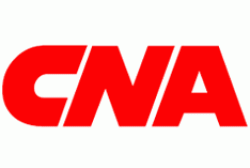 Wall Street analysts predict that CNA Financial (NYSE:CNA) will report $2.57 billion in sales for the current fiscal quarter, according to Zacks Investment Research. Two analysts have issued estimates for CNA Financial’s earnings. CNA Financial reported sales of $2.32 billion in the same quarter last year, which indicates a positive year-over-year growth rate of 10.8%. The business is expected to report its next quarterly earnings report on Monday, July 30th.
Wall Street analysts predict that CNA Financial (NYSE:CNA) will report $2.57 billion in sales for the current fiscal quarter, according to Zacks Investment Research. Two analysts have issued estimates for CNA Financial’s earnings. CNA Financial reported sales of $2.32 billion in the same quarter last year, which indicates a positive year-over-year growth rate of 10.8%. The business is expected to report its next quarterly earnings report on Monday, July 30th.
According to Zacks, analysts expect that CNA Financial will report full-year sales of $10.31 billion for the current fiscal year, with estimates ranging from $10.30 billion to $10.33 billion. For the next year, analysts forecast that the company will report sales of $10.74 billion per share, with estimates ranging from $10.60 billion to $10.88 billion. Zacks’ sales averages are an average based on a survey of analysts that that provide coverage for CNA Financial.
Get CNA Financial alerts:
CNA Financial (NYSE:CNA) last issued its quarterly earnings data on Monday, April 30th. The insurance provider reported $1.07 earnings per share (EPS) for the quarter, topping the Thomson Reuters’ consensus estimate of $0.91 by $0.16. The firm had revenue of $2.52 billion during the quarter, compared to the consensus estimate of $2.38 billion. CNA Financial had a net margin of 9.54% and a return on equity of 8.06%. During the same period last year, the business posted $0.87 earnings per share.
Several brokerages have issued reports on CNA. ValuEngine downgraded shares of CNA Financial from a “buy” rating to a “hold” rating in a research report on Monday, May 14th. Zacks Investment Research cut shares of CNA Financial from a “buy” rating to a “hold” rating in a report on Tuesday, April 17th.
CNA stock traded down $0.03 during mid-day trading on Thursday, hitting $49.27. 145,279 shares of the company were exchanged, compared to its average volume of 240,956. The company has a quick ratio of 0.23, a current ratio of 0.23 and a debt-to-equity ratio of 0.23. The company has a market capitalization of $13.37 billion, a PE ratio of 14.58, a price-to-earnings-growth ratio of 2.36 and a beta of 1.20. CNA Financial has a 1-year low of $43.95 and a 1-year high of $55.62.
The firm also recently announced a quarterly dividend, which will be paid on Wednesday, May 30th. Stockholders of record on Monday, May 14th will be issued a dividend of $0.30 per share. The ex-dividend date of this dividend is Friday, May 11th. This represents a $1.20 annualized dividend and a dividend yield of 2.44%. CNA Financial’s dividend payout ratio is presently 35.50%.
In other news, EVP Scott L. Weber sold 1,486 shares of the firm’s stock in a transaction that occurred on Friday, March 2nd. The shares were sold at an average price of $49.83, for a total transaction of $74,047.38. Following the transaction, the executive vice president now directly owns 2,382 shares of the company’s stock, valued at $118,695.06. The sale was disclosed in a legal filing with the Securities & Exchange Commission, which can be accessed through the SEC website. Also, EVP Douglas Worman sold 11,396 shares of the firm’s stock in a transaction that occurred on Thursday, May 3rd. The stock was sold at an average price of $47.66, for a total transaction of $543,133.36. Following the transaction, the executive vice president now directly owns 17,273 shares in the company, valued at $823,231.18. The disclosure for this sale can be found here. 0.18% of the stock is currently owned by company insiders.
A number of large investors have recently made changes to their positions in CNA. Systematic Financial Management LP bought a new position in CNA Financial in the fourth quarter valued at approximately $23,551,000. Allianz Asset Management GmbH increased its stake in CNA Financial by 43.9% in the first quarter. Allianz Asset Management GmbH now owns 657,337 shares of the insurance provider’s stock valued at $32,439,000 after acquiring an additional 200,582 shares during the last quarter. Arrowstreet Capital Limited Partnership increased its stake in CNA Financial by 110.7% in the fourth quarter. Arrowstreet Capital Limited Partnership now owns 373,588 shares of the insurance provider’s stock valued at $19,819,000 after acquiring an additional 196,288 shares during the last quarter. Mackay Shields LLC bought a new position in CNA Financial in the first quarter valued at approximately $8,700,000. Finally, Prudential Financial Inc. increased its stake in CNA Financial by 70.8% in the first quarter. Prudential Financial Inc. now owns 331,811 shares of the insurance provider’s stock valued at $16,375,000 after acquiring an additional 137,500 shares during the last quarter. 99.72% of the stock is currently owned by institutional investors and hedge funds.
CNA Financial Company Profile
CNA Financial Corporation provides commercial property and casualty insurance products primarily in the United States. It operates through Specialty, Commercial, International, Life & Group, and Corporate & Other segments. The company's property insurance products include property, marine, boiler, and machinery coverages; and casualty insurance products comprise workers compensation, general and product liability, commercial auto, and umbrella coverages.
Get a free copy of the Zacks research report on CNA Financial (CNA)
For more information about research offerings from Zacks Investment Research, visit Zacks.com

 Superconductor Technologies Inc., together with its subsidiaries, develops, produces, and commercializes high temperature superconductor materials and related technologies in the United States. It is involved in developing Conductus superconducting wire for power applications. The company was founded in 1987 and is headquartered in Austin, Texas.
Superconductor Technologies Inc., together with its subsidiaries, develops, produces, and commercializes high temperature superconductor materials and related technologies in the United States. It is involved in developing Conductus superconducting wire for power applications. The company was founded in 1987 and is headquartered in Austin, Texas. Airgain, Inc. designs, develops, and engineers antenna products for original equipment and design manufacturers, chipset vendors, and service providers worldwide. Its products include MaxBeam embedded antennas; profile embedded antennas; profile contour embedded antennas; ultra-embedded antennas; omnimax high performance external antennas; MaxBeam carrier class antennas; and SmartMax embedded antennas, as well as automotive, fleet, public safety, and M2M antennas. The company provides embedded antenna technologies to enable high performance wireless networking across a range of home, enterprise, automotive, and Internet of Things. As of December 31, 2017, it had 131 issued patents in the United States, 23 companion patents outside the United States, and 81 patent applications on file. The company was formerly known as AM Group and changed its name to Airgain, Inc. in 2004. Airgain, Inc. was founded in 1995 and is headquartered in San Diego, California.
Airgain, Inc. designs, develops, and engineers antenna products for original equipment and design manufacturers, chipset vendors, and service providers worldwide. Its products include MaxBeam embedded antennas; profile embedded antennas; profile contour embedded antennas; ultra-embedded antennas; omnimax high performance external antennas; MaxBeam carrier class antennas; and SmartMax embedded antennas, as well as automotive, fleet, public safety, and M2M antennas. The company provides embedded antenna technologies to enable high performance wireless networking across a range of home, enterprise, automotive, and Internet of Things. As of December 31, 2017, it had 131 issued patents in the United States, 23 companion patents outside the United States, and 81 patent applications on file. The company was formerly known as AM Group and changed its name to Airgain, Inc. in 2004. Airgain, Inc. was founded in 1995 and is headquartered in San Diego, California. Wall Street analysts predict that CNA Financial (NYSE:CNA) will report $2.57 billion in sales for the current fiscal quarter, according to Zacks Investment Research. Two analysts have issued estimates for CNA Financial’s earnings. CNA Financial reported sales of $2.32 billion in the same quarter last year, which indicates a positive year-over-year growth rate of 10.8%. The business is expected to report its next quarterly earnings report on Monday, July 30th.
Wall Street analysts predict that CNA Financial (NYSE:CNA) will report $2.57 billion in sales for the current fiscal quarter, according to Zacks Investment Research. Two analysts have issued estimates for CNA Financial’s earnings. CNA Financial reported sales of $2.32 billion in the same quarter last year, which indicates a positive year-over-year growth rate of 10.8%. The business is expected to report its next quarterly earnings report on Monday, July 30th.